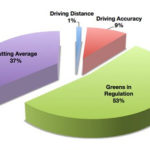The Swing Change Process
by: B. J. Hathaway
Changing major errors in your golf swing can be difficult and frustrating. Why can’t we just decide what needs to be done differently and have it immediately show up?
The first step is locating the origin of the error that you are trying to change. We can determine if the problem is philosophical or mechanical.
Philosophical Errors
What is your objective in each golf shot? The correct answer is to move the ball from one location to another with the correct speed, precision and accuracy, but what if your philosophy is wrong? A good example: “I believe when a ball is on the ground (not on a tee) that I need to get under the ball and lift it in the air”. Because your philosophy is wrong, your brain will automatically move the body and club in a way to achieve the objective thus producing technical swing errors.
Technical Errors
These errors are easily discovered through video analysis such as casting, flipping, loss of posture, etc. Many times these can be linked to a philosophy error but can also be attributed to poor resource information.
Attempting Change
For whatever reason, somewhere along the way either consciously or not, we build a swing through multiple trials to achieve the objective of “hitting” the ball. If the swing is not technically sound it will contain one or more major errors but let’s assume only one. This one major error will require an equally powerful countermeasure to equal out the system, but this compensation may require a third compensation move to balance out the first two combinations. Remember we are always trying to control the distance, direction and ground strike components in each golf swing.
This golf swing now has three (or more) compensation moves that require perfect timing and coordination to hit a quality golf shot.
So Mr. X either through self-discovery or the help of his golf professional learns of a major error in his golf swing that needs change. He begins the process of attempting the change but soon discovers his ball flight is worse and he becomes frustrated an automatically reverts back to his old swing. Since his brain has stored the old swing as an automatic process, he is literally trapped by his own mind. He must choose to either keep attempting the swing change or accept that his full swing will never improve.
Why it’s Difficult
Mr. X may come to understand the error that needs changing and even agree with the diagnosis and believe it’s the correct thing to do for the long-term improvement he craves but he doesn’t realize that his mind is much quicker than his body. He begins a new swing thinking about the new change but somewhere in the 1.25 seconds of the swing his brain fires thoughts like “this is very uncomfortable” and “this feel strange so it’s can’t be correct” or “I cannot even hit the ball like this” or “but my distance and accuracy will suffer” or similar thoughts. So now somewhere later in the swing his brain automatically reverts back to what feels comfortable and that he trusts. He now makes the same old swing errors again because of discomfort, disbelief and a focus on outcome.
Ultimately he has to train the new move in a new context that is not based on shot outcome and trusting that although the change feels uncomfortable it is ultimately exactly what he needs to do. Short of hypnosis, this is the only way to change your swing errors.











